Haderslev,Denmark 作者: 来源: 发布时间:2021-06-18
一、人口,面积,所属地区
Population: 55,670
Area: 813 km²
Municipality in Syddanmark
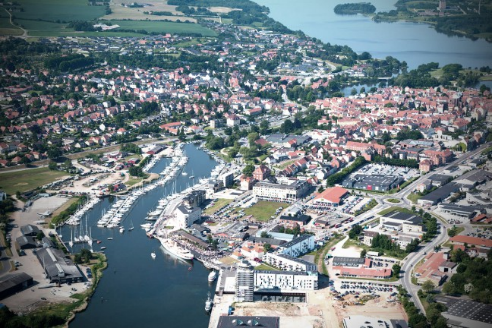
二、自然地理(或者地理环境、自然资源、交通情况)
Haderslev is a town and municipality on the east coast of the Jutland peninsula in south Denmark. Also included is the island of Årø as well as several other smaller islands in the Little Belt. It belongs to Region of Southern Denmark. The municipality is also a part of the East Jutland metropolitan area where it makes up the most southern part.
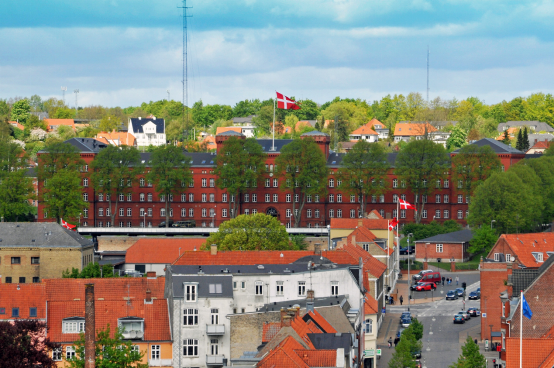
The waters of Haderslev Fjord cut into the municipality from the Little Belt, dividing the city north-to-south, and becoming Haderslev Dam, west of the city center. Årø Strait separates the bulk of the municipality from the island of Årø, and the two are connected by ferry service between the town of Årøsund on the mainland and the town of Årø on the island.
The main town and the site of its municipal council is the city of Haderslev. It is situated in the eastern part of Southern Jutland. Haderslev is home of Sønderjyske, which is an association football team that plays in the Danish Superliga for the 2015-16 season.
Transport
Vojens Airport is centrally located in the Region of Southern Denmark with take-off and landing facilities open to all types of flight-related tasks.
三、经济发展和规模
The Triangle area is entering a new region these years as a region chapter. Historically, the municipality is a community created by a special one infrastructure and with framework conditions set by the modern Denmark's business development. Structural reform spurred the municipalities' strategic cooperation. These years are changing technology and globalization in both Denmark and Triangle area, and we are now choosing a more focused, strategic one Community. The triangle area is one of Denmark's central growth centers. Our positions of strength and the favorable location in the middle in the country, as the link between the continent and the North, makes us the hub of Denmark. It commits. We create connection both nationally and internationally, and we rest Denmark for the future with a common focus on smart growth and development. For hundreds of years we have been the hub of the country royal seat to production center. We also intend to be in the future with hundreds of thousands of workplace.
The triangle area is an option community characterized by reason and the added value that work can accommodate if we give each other the law and space to succeed yourself. Municipalities, businesses and citizens can and must choose their own paths, and together we can in The triangle area creates smarter growth through a sharp focusing on the elements that create skills, jobs and quality of life. This common strategy for growth and attractiveness must be in the The framework for our collaboration will be the coming year.
The triangle area has for many decades been Denmark's perhaps-buy industrial region. Strong production industries, a good infrastructure trip and a central location were important assets for the Triangle area in the struggle for investment, export markets and jobs from 1960-2000.After the financial crisis, the position of the Triangle area was challenged. Industry-one filled less and less in the Danish economy and large parts of production was outsourced to Eastern Europe and Asia. Since 2013 is however, creating more than 4,000 new jobs in the Trekan industry ytområdet. This is not least due to an undergrowth of highly productive, international small and medium-sized industrial companies that is doing really well. The result is that the Triangle area in 2018 has more than 37,000 jobs in the industry - and thousands of jobs in industry that support and depend on the industry. Today, the Triangle area is therefore still highly specialized within production business. Specialization even seems to be on the rise. That supports the Triangle area's position as Denmark's production center. But it also illustrates the importance of ensuring good frameworks. more for industrial companies, as they are the basis for a significant share of area employment and wealth development. Industry in the Triangle area does better than the national average and is a major contributing factor to our GDP being the highest Denmark after the capital.
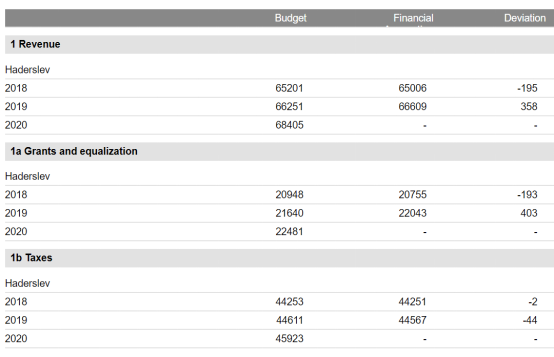
*All amounts are in DKK per. per capita in current prices
四、产业特点/重点项目
The municipality's occupational strength positions are in furniture / clothing, food and transport, but there has been a large increase in the number of jobs in medical / health in the period 2014-2016. Conversely, the number of jobs in both furniture / clothing and food has decreased over the same period.
Focus areas
Interaction with nationalclusters
International Power Center forcircular production
Tourism
Transport tand logistics
Strengthening the food industry
Project
ACE Denmark
ACE Denmark is a public-private partnership. The goal of this is to be able to create a high-tech development park for logistics, training and simulation, maintenance and training.
Haderslev kom, in collaboration with a number of actors, has established a public-private collaboration. Namely ACE Denmark - Aeronautical center and Excellence. Based on the skills of the Fighter Wing Skrydstrup, the goal is to create a high-tech development park for aircraft maintenance, both military and civil aircraft.
ACE Denmark must be the physical and organizational framework for a number of companies and institutions that together with the Armed Forces can contribute to the operation and maintenance of air vehicles.
On the basis of Fighterwing Skrydstrup skills and qualifications, Haderslev Municipality has set up a public-private establishment carving itself into a highly technological market, within the sector of maintenance of both military and civilian plans.
The Aeronautical Center of Excellence –ACE Denmark, represents the physical and organizational framework of a number of companies and institutions cooperating with the Ministry of Defense.
In a broader perspective, the establishment of Ace Denmark supports both the financial and social security policy, achieving a synergy for everyone to gain.
Haderslev Harbor
Haderslev Harbor has developed into a new and modern district in Haderslev with housing, commercial leases, institutions and recreational offers. The transformation is still ongoing.
Ongoing projects
Honnørkajen
The blue association house
Establishment of public areas, infrastructure and harbor promenade
Projects you can see at Haderslev Harbor
General housing - "Søslangen", Domea
Payment Denmark - regional center listed under ATP
Senior Living Community - "Strandhusene", HAB
Private office building - "Skipperhuset"
Establishment of canals and mirror water basin
VUC Lighthouse
StreetDome
Flow Factory, VUC South
Decorating the silo - Denmark's tallest mural by Victor Ash
The transformation of Haderslev Harbor from a commercial and traffic port into a modern and attractive district is based on the master plan for Haderslev Harbor and the associated design manual. These plans are important tools and provide inspiration for creating the framework for the architectural design of the port area.
五、风景名胜,景点
Slivsø
Address: Hoptrup Hovedgade 11, 6100 Haderslev
Slivsø near Hoptrup south of Haderslev was drained in 1957-59 so the area could be used for farmland. It was restored in 2004 on a slightly smaller scale with 164 hectares, the equivalent of 300 football fields. The first birds were quick to settle here, once the water was let back into the lake, and today the lake is home to around 180 different species of birds.
One of the best ways to see Slivsø is to follow the marked paths. The path along the northern bank is app. 3,5 kilometers long and takes you close to the lake and animals. From the old pumping station, which has been remodelled into a look.out, there is a wonderful view of the lake and the many birds.
The path south of the lake is app. 2,5 kilometers long, and offers a stunning panoramic view of the lake and the hilly landscape. If you pass through Diernæs and Hoptrup you can combine the two trails. That would make the combined route 9 kilometers long.
It is allowed to sail canoes, kayaks and motor-less boats in the centre of the lake. You can also sail downstream by Hoptrup Å to reach Diernæs Bay.
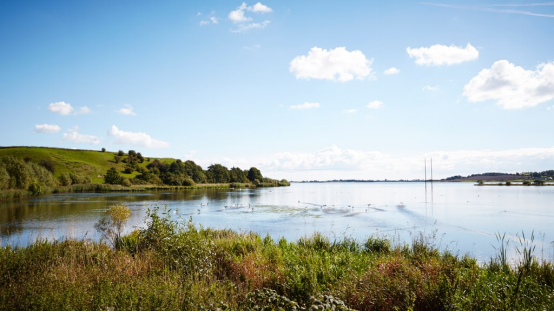
The red water tower
Address: Parkvej 5A, 6100 Haderslev
The water tower was build in 1924 and worked toward plentiful and clean water-source for the town population that only grew after the reunion. The tower was first put to use on first of January 1925. The tower was made of concrete and wrapped with red brick.
The tower added with its height a sight attraction in Haderslev. An exiting viewpoint can be reached from the top of the tower. There was public access to the tower from 1924-1966. The view of the town rooftops, green land and blue water is beautiful.
Since then a second 'white tower' was added to Haderslev at christiansfeldvej in 1991 and the red water tower was no longer put to use as a water tower.
The water tower has two functions today: one is to hold high the advent star in the last couple of weeks of the year. The second is to function as a symbol for the annual music festival 'Kløften festival', on the first day of summer break in June.
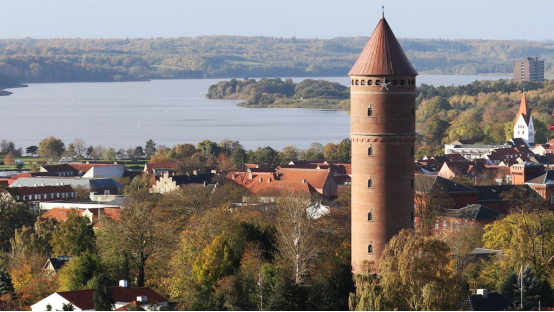
六、历史文化
Haderslev is situated in a valley, leading from Vojens to Haderslev Fjord and the Baltic Sea. Haderslev was presumably founded by Vikings at least a century before it was granted status as royal borough in 1292. At that time, it had become one of the main trading centres in Southern Jutland. In 1327, Haderslevhus, the royal castle, was mentioned for the first time. It was situated east of the cathedral; an area still called Slotsgrunden. In the following centuries the city prospered, building both the Gothic Cathedral and the second castle of Hansborg (burnt in 1644), which was similar to Kronborg. Due to the plague in Copenhagen, King Christian IV was married there. In the 16th century, the city became one of the first Scandinavian places to embrace the Lutheran Reformation. Prior to the Second Schleswig War of 1864, Haderslev was situated in the Duchy of Schleswig, a Danish fief, so its history is properly included in the contentious history of Schleswig-Holstein. From 1864 it was part of Prussia, and as such part of the North German Confederation, and from 1871 onwards, part of the German Empire. In the 1920 Schleswig Plebiscite that returned Northern Schleswig to Denmark, 38.6% of Haderslev's inhabitants voted for remaining part of Germany and 61.4% voted for the cession to Denmark. It was formerly the capital of the German Kreis Hadersleben and the Danish Haderslev County.
The trademark of Haderslev is unquestionably Haderslev Cathedral, which has existed since the middle of the 13th century, and since 1922 it was the seat of Haderslev Diocese. The town was an important breeding ground for the reformation in Denmark, and as early as 1526 Christian introduced, as the duke of Schleswig-Holstein, the reformation in Haderslev, just eight years before he became King of Denmark. Another noticeable church is the white-chalked Sankt Severin Church, which lies at the banks of the town's inner pond.
Because of a renovation of the town's oldest houses, it means Haderslev offers a unique collection of houses and buildings from 1400 to the beginning of 20th century, and the town center's cobbled streets and alleys is very suitable for town strolling.
Once the town used to have a castle named "Haderslev Hus", but due to several town fires through the town's history the castle is no longer existent.
In the public park "Kløften", near the town's center, Kløften Festival, a three-day annual festival is in the summer. The festival uses one of Haderslev's important trademarks, the red-bricked water tower near the park as their logo.
A kommune by the previous name existed 1970–2006. It belonged to South Jutland County and covered an area of 272 square kilometres (105 sq mi) with a total population of 56,116 (2011). Its last mayor was Hans Peter Geil, a member of the liberal (Venstre) political party.
Neighboring municipalities were Christiansfeld to the north, Vojens to the west, Rødekro to the south, and Assens (on the island of Funen) to the East.
On January 1, 2007 Haderslev municipality was, due to Kommunalreformen ("The Municipal Reform" of 2007), merged with the former municipalities of Gram and Vojens, as well as Bjerning, Hjerndrup, and Fjelstrup parishes of Christiansfeld Municipality and Bevtoft parish of Nørre Rangstrup Municipality.
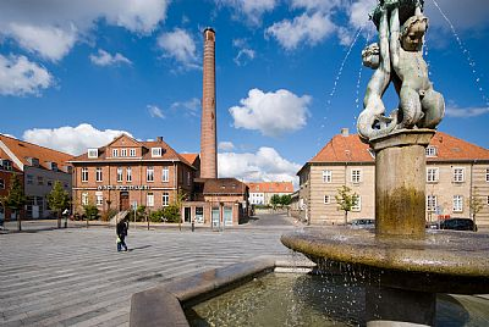
七、联系方式
Mayor: HP Geil
Address: Pedestrian street 26, 6100 Haderslev
Telephone: 29 18 97 57
mail: post@haderslev.dk.
Facebook: https://www.facebook.com/haderslevkommune/
Website: https://www.haderslev.dk/
